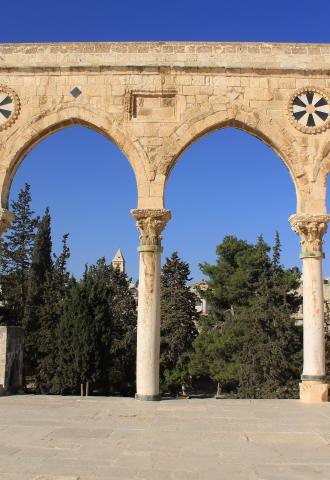The Temple Mount
 These 35 acres have been called the most valuable real estate in the world today. It was here on this man-made platform that Jesus was presented as a baby, worshipped God, and was left behind at Passover as a boy. As a man, He flipped over the moneychanger tables, castigated the hypocrisy of Scribes and Pharisees, and proclaimed Himself the Messiah.
These 35 acres have been called the most valuable real estate in the world today. It was here on this man-made platform that Jesus was presented as a baby, worshipped God, and was left behind at Passover as a boy. As a man, He flipped over the moneychanger tables, castigated the hypocrisy of Scribes and Pharisees, and proclaimed Himself the Messiah.
Definitely the highlight of your trip, both above and below ground, it can be challenging to sort out this ancient city since it changed hands so many times. Originally chosen because of the Gihon Spring, this trapezoid became the spiritual center of the universe for Jews, Muslims, and Christians.
Also known as Mount Moriah, this is where Abraham offered up his son Isaac (Genesis 22), the site of the windy threshing floor that David bought from the Jebusites for the first Temple (2 Chronicles 3:1), and where Solomon would ultimately build the temple around 950 B.C. His Temple stood here for over 400 years until the Babylonians destroyed it in 586 B.C. The Temple was rebuilt when Cyrus sent the Jews home under the guidance of Zerubabbel (538 B.C.) and Ezra (515), although it took a long time to complete and was not nearly as grand as the first Temple.
Herod the Great began the 80-plus year Temple re-build in 20 B.C., enlarging this Second Temple to hold more worshippers, and thereby make more money from them. In the massive project, he buried Solomon’s Palace. Josephus described it as “a structure more noteworthy than any under the sun. The height of the portico was so great that if anyone looked down from its rooftop he would become dizzy.” It was this Temple that Titus destroyed in 70 A.D., when he crushed the Great Revolt and left the rubble Jesus had predicted (Matthew 24).
Hadrian demolished the city again around 130 A.D., built a new city here called Aelia Capitolina, and set up his own temple to the god Venus. Part of this effort was to destroy the site of the resurrection tomb and Golgotha by filling it in with rubble and dirt. The new Christian Emperor Constantine removed the rubble and built the Church of the Holy Sepulchre 200 years later.
The Dome of the Rock, where Muslims think Muhammad ascended to Heaven, dominates the heights now. In the 7th century, the Muslims conquered Jerusalem and erected the Dome of the Rock. The inside is not open to non-Muslims (although you can sometimes get up to see the outside area in the morning). In 1537, the Sultan Suleiman the Magnificent built the present day walls around the city. They were rebuilt on the foundations of walls from the Second Temple and the Roman expansion.
There are several Gates to the city of Jerusalem, with the Golden Gate (the East Gate) being the most important and impressive because the Messiah will return and walk through it (Ezekiel 44:1-3). The stones date to the time of Nehemiah (445 B.C.), and it is the only gate Suleiman did not rebuild. Suleiman sealed this gate instead, and just in case the walled up gate failed to stop the Messiah, they added a Muslim cemetery in front of the gate to thwart His approach.
Perhaps the most emotional stop for all tourists is the Western Wall (Wailing Wall), a 185-foot retaining wall that surrounded the Temple platform (not actually part of the Temple itself). When the Romans destroyed the Temple in 70 A.D., they brazenly left this retaining wall as a testament to their power.
Just south of the Western Wall, at the far corner, is Robinson’s Arch (named after the American archaeologist Edward Robinson), which is now just a 50-foot stub. It was originally a staircase from the Herodian street up to the Temple. This street is original to the time of Christ (you can see several shops here from this time period), and so is the damage the Romans did to it when they threw down blocks of stone from the Temple’s destruction. Their boulders can even be seen in the smashed ceiling of the tunnel beneath the street!
Half of the Wall is below ground, where the famous “Rabbinical Tunnel” runs through the north end of the room formed by the arch closest to the Western Wall. The underground areas are fascinating archaeologically, allowing you to get within meters of the Holy of Holies site underneath the Second Temple. These tunnels reveal the massive lower Wall stones, the foundation of everything above, which sit right on the bedrock (one stone weighs over 500 tons and is 40 feet long–the largest stone ever quarried). The skill in their construction is evidenced by how tight they fit together, barely allowing a sheet of paper to pass between them.
Standing on these 35 acres, where the Temple sacrifices centered the Jewish people’s love for the God of Abraham, is an emotional experience that is almost beyond description. No wonder so many weep at the Western Wall.

0 Comments